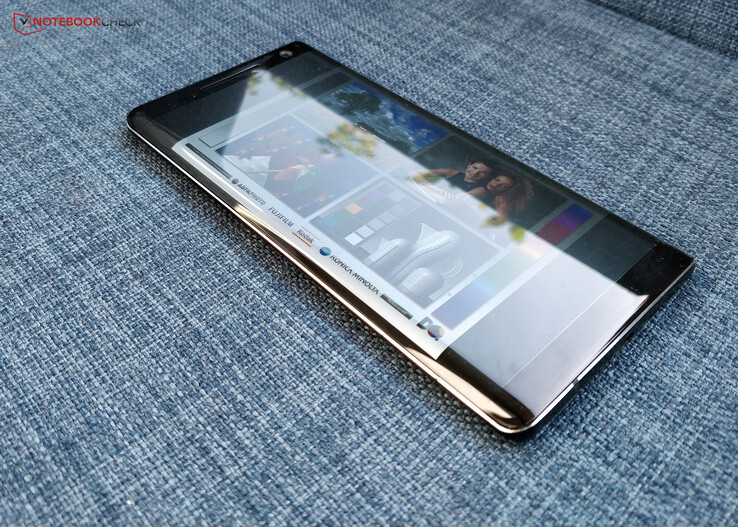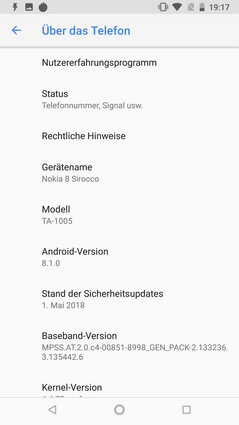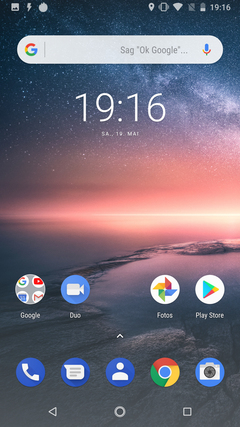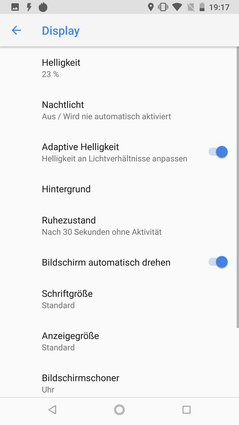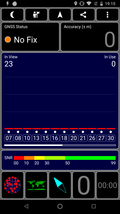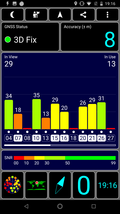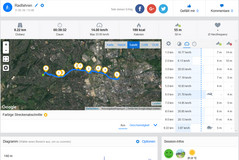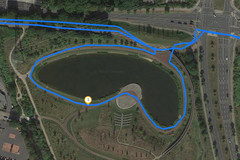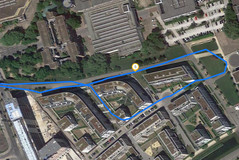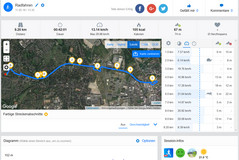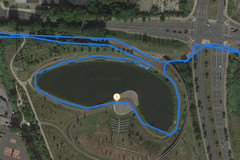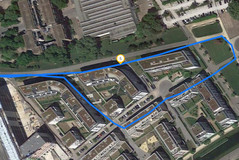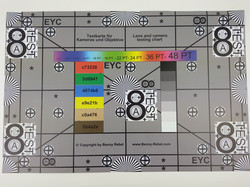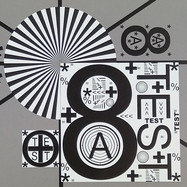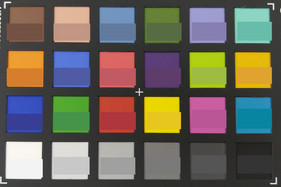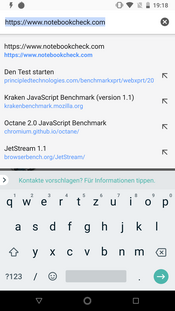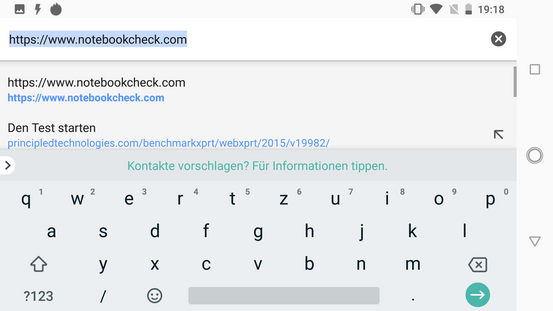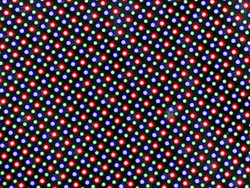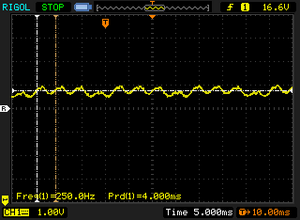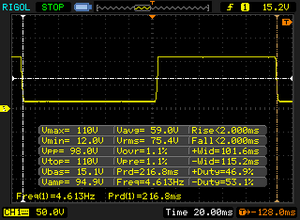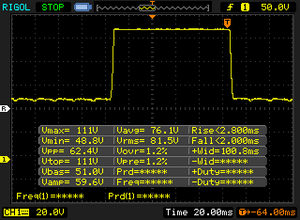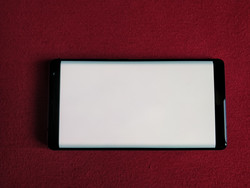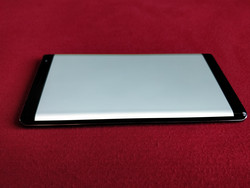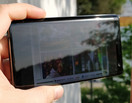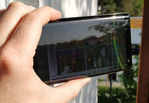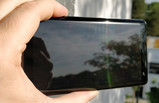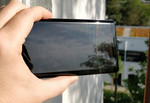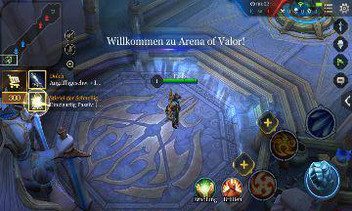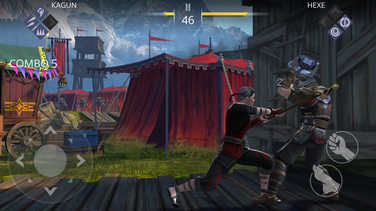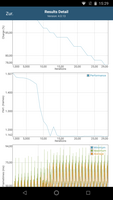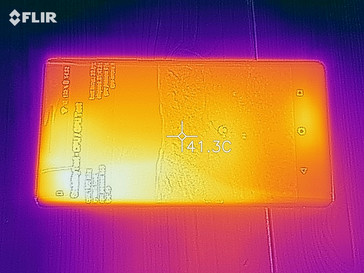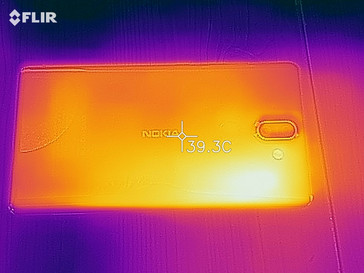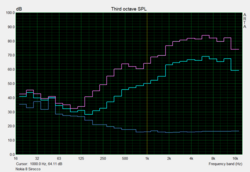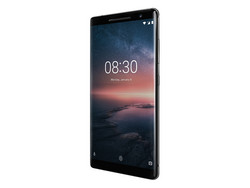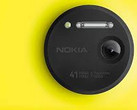Nokia 8 Sirocco Smartphone Review
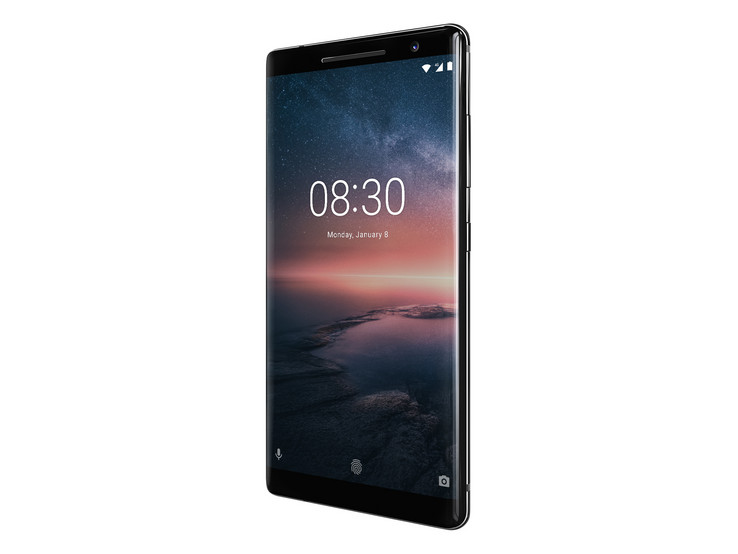
The name Sirocco actually designates the wind that regularly blows sand from the Sahara Desert into Central Europe. In the case of the Nokia, however, it stands for legendary high-quality designer phones. The Nokia 8800 Sirocco is still being traded online for high prices. Ever since Nokia started making Android smartphones, fans have been impatiently waiting for a Sirocco model - and here it is: The Nokia 8 Sirocco is available online for a price of $600 and has an unusual stainless-steel case, a camera with a Zeiss lens and pure Android. However, it is still equipped with Qualcomm's previous SoC generation. Can it keep up with current flagship devices?
Today's comparison devices are the normal Nokia 8, the Sony Xperia XZ2, the Motorola Moto Z2 Force, the Huawei P10 Plus and the Samsung Galaxy S9.
Case – very stable stainless-steel case
Around the turn of the century, Nokia was famous for constantly creating new form factors for mobile phones that were still easy to use. This way, every user could find the right phone for them. The Nokia 8800 Sirocco was Nokia's 2006 spearhead. It has a sliding mechanism and high-quality metal case. The Nokia 8 Sirocco is meant to take up this tradition of unusual but high-quality designs: It has a stainless-steel case with narrow sides and looks very attractive. The strongly curved glass at the front is a real eye-catcher and even the back is covered in glass, which is good news for the strength of the antennas and looks elegant. However, the glass also shows up fingerprints and greasy marks very easily.
The Nokia 8 Sirocco weighs 176 grams (~6.2 oz) and has a 16:9 form factor, which by now can almost be considered unusual. Therefore, the device is shorter and slightly wider than the comparison devices. The phone is nice to handle, and the workmanship feels very good. The only color currently available is black with some chrome features.
The device is resistant to pressure and cannot be warped, giving it a high-quality feel. The case has an IP67 certification, which means it is protected against dust and water at a depth of up to one meter (~3 ft).
Connectivity – high storage capacity, no MHL
With 128 GB of fast UFS 2.1 storage and 6 GB of RAM, the Nokia 8 Sirocco is well-equipped for a high-end smartphone. However, you should be aware that the storage capacity of our test unit cannot be expanded with a microSD card. On the internet the Nokia 8 Sirocco is available with Dual-SIM support, which apparently can also be used for a microSD. The pure Android OS means that you have 114 GB of storage available for personal use. This should keep you going for quite a while.
The Nokia 8 Sirocco does not offer a 3.5-mm audio jack. Instead, you can connect headphones via the USB-C port. This port also supports USB-OTG, but no MHL (image output through USB-C).
Software – pure Android
Nokia uses Android One on all its smartphones, including the Nokia 8 Sirocco. This means that the manufacturer provides a pure version of Android without any big changes to the operating system and that Google promises to provide OS updates for two years. Our Nokia smartphone therefore runs the current version of Google's OS (Android Oreo 8.1) and has all current security patches installed. At the time of writing, these are from the beginning of May 2018. The device has no software pre-installed apart from the usual Google apps and users are free to set up the phone as they wish.
Communication and GPS – average Wi-Fi reception
Of course, it is a must for a high-end smartphone to offer fast Wi-Fi that supports the 802.11 a/b/g/n/ac bands. However, the Nokia 8 Sirocco shows rather moderate reception speeds in our test with the reference router Linksys EA8500. We had already noticed this with the Nokia 8. The transmission rates are on the same level as those of other flagship phones. We felt that pages loaded at average speed during our practical test while images took a while to load at first, but then appeared quite quickly after scrolling for a while. We had full reception close to the router and 50% reception at a distance of 10 meters (~33 ft) and through three walls. However, there were some occasional issues with the connection at this distance and some pages loaded very slowly or not at all. Turning the smartphone to face the router made the pages load faster again.
The LTE speed is decent at up to 600 MBit/s (download) and up to 150 MBit/s (upload) and faster than those of the Nokia 8. However, other devices such as the Sony Xperia XZ2 and the Samsung Galaxy S9 are quite a bit faster. They can reach download speeds of up to 1200 MBit/s. You would need to be sending very large amounts of data and have a mobile network that supports these speeds for these maximum speeds to be noticeable in practice. For example, Vodafone Germany offers a maximum download rate of 500 MBit/s via LTE in theory, but states on its website that independent tests have shown that the average rates in urban areas are 44.53 MBit/s (download) and 18.83 MBit/s (upload). The Nokia 8 Sirocco supports 14 LTE frequencies, which should be enough to find a suitable LTE network when on holiday. Compared to the 21 frequencies the Sony Xperia XZ2 has to offer, on the other hand, this is not much.
| Networking | |
| iperf3 transmit AX12 | |
| Sony Xperia XZ2 | |
| Motorola Moto Z2 Force | |
| Nokia 8 Sirocco | |
| Samsung Galaxy S9 | |
| Nokia 8 | |
| Huawei P10 Plus | |
| iperf3 receive AX12 | |
| Sony Xperia XZ2 | |
| Samsung Galaxy S9 | |
| Motorola Moto Z2 Force | |
| Nokia 8 Sirocco | |
| Nokia 8 | |
| Huawei P10 Plus | |
The Nokia phone cannot locate us indoors. It takes some time to position us outdoors, but then offers decent accuracy within 6 meters (~20 ft).
Our bike trip with the Nokia 8 Sirocco and the Garmin Edge 500, a professional navigation system for cyclists, shows very similar results in the measured routes and there seem to be hardly any issues with the smartphone's tracked route. It was actually even more precise than the Garmin Edge during our loop. However, the smartphone seems to have significant difficulties locating us correctly when using Google Maps. It takes very long to recognize our position and even then, the compass always points in the wrong direction. Overall, the Nokia 8 Sirocco can only be recommended with reservations: If you use the navigation function regularly and depend on it, you might not want to rely on this smartphone.
Telephone and Call Quality – a good microphone
Following the Android One philosophy, the Nokia's telephone app is Google's standard app. This Android app is easy to use and offers quite a lot of functions, such as direct access to contacts, a good overview of your call history and the possibility to block certain numbers. The smartphone supports VoLTE, but phone calls cannot currently be made via Wi-Fi.
The call quality is good overall, but the earpiece tends to drone a little at high volume. We did not notice any background noises and the voice of our call partner was transmitted clearly at low and medium volume. We were also impressed by the microphone: It picked up our voice very clearly. The included speakerphone mode transmitted our voices clearly even when talking very quietly.
Cameras – good main dual camera, mediocre front camera
The back of our test unit features a dual camera from Zeiss, while the front has a single lens without LED flash. Let us first talk about the selfie camera, as we were not particularly impressed by it: The pictures taken by the 5-MP sensor have very few details in light areas which leads to strange color transitions. In addition, pictures loose sharpness around the edges. In dark areas, the camera does a good job of lightening up the picture and the screen can also be used as a flash.
The back camera has a 12-MP wide-angle lens and a second lens with a 13-MP telephoto lens. At f/1.7, the main camera is quite light-sensitive and takes sharp photos even in dark settings, although they could be lightened up more. The Huawei P20 Pro does a significantly better job here. We are happy with the pictures the Nokia smartphone takes under normal lighting conditions. Colors appear natural and sharpness is good, although some details are lost in bright areas. The dual camera with different focal lengths can create a small optical zoom and also improves digital zoom. The camera can also take pictures with the Bokeh effect and has a live preview for this. In our test, this function decreased the sharpness of the main motive significantly.
Videos can be recorded in 4K with the main camera and offer very good image quality and sharpness. In addition, you can record Surround sound via three microphones. The microphones are supposed to create good recordings even in very loud surroundings. There is a slow-motion function that can make videos up to 4x slower. These videos are probably recorded at 120 FPS. The resulting effects are fun but not particularly impressive as they are not that slow.
We did some more tests on the main camera in our lab and photographed our test chart and the ColorChecker Passport. The result was very pleasing: The sharpness of the test chart is good, and the color fields are reproduced clearly. There is only some difficulty with reproducing text on a red background.
Colors could be a little more saturated.
Accessories and Warranty – a lot of accessories
HMD Global, the Nokia manufacturer's official name, has included quite a selection of accessories with the phone: There is a QuickCharge power supply plus a USB cable, a headset, a SIM tool and a Quick Start Guide as well as security information in numerous languages. In addition, users also receive a transparent hard plastic case that is definitely a good idea if you want to protect your phone from damage, but somewhat reduces the attractiveness of the smartphone. There are currently no other official accessories available for this phone in the Nokia shop.
The Nokia comes with a 24-month warranty. Please see our Guarantees, Return policies and Warranties FAQ for country-specific information.
Input Devices & Handling – a very precise touchscreen
The pre-installed keyboard app is Google's GBoard, which is fast and easy to use and offers the possibility of voice input, swiping instead of typing and changing the design of the keyboard. Other keyboard apps can be downloaded from the Google Play store.
The touchscreen is very fast, and its surface has good gliding properties. It responds reliably even at the curved edges and is easy to handle. It does not offer a glove mode for winter.
There is a fingerprint reader on the back that is easy to find due to its slightly elevated edges. It wakes and unlocks the smartphone from standby quickly and reliably.
The Android buttons are on the screen and the only two hardware buttons (volume rocker and standby button) are positioned on the right side of the case. They are made of the same material as the rest of the frame but are easy to find due to small grooves.
Display – OLED screen with blue cast
The 5.5-inch screen still has a 16:9 format, which is good news for displaying videos, as this format avoids the black strips on either side of the video that 2:1 displays have. The OLED screen is not bezel-free, but looks very elegant due to the curved glass. The resolution is just as high as that of any other current high-end smartphone at 2560x1440 pixels.
The screen has a brightness of 576 cd/m². This is a good value, but significantly lower than that of the Nokia 8. The Motorola Moto Z2 Force or the Samsung Galaxy S9 are quite a lot darker. The maximum brightness levels can only be reached via the ambient light sensor. If you turn that off, the maximum brightness is limited to 390 cd/m².
The brightness distribution of 85% is not as even as on other devices.
| |||||||||||||||||||||||||
Brightness Distribution: 85 %
Center on Battery: 576 cd/m²
Contrast: ∞:1 (Black: 0 cd/m²)
ΔE ColorChecker Calman: 5 | ∀{0.5-29.43 Ø4.77}
ΔE Greyscale Calman: 5.4 | ∀{0.09-98 Ø5}
Gamma: 2.3
CCT: 7730 K
| Nokia 8 Sirocco P-OLED, 2560x1440, 5.5" | Sony Xperia XZ2 IPS, 2160x1080, 5.7" | Motorola Moto Z2 Force OLED, 2560x1440, 5.5" | Samsung Galaxy S9 Super AMOLED, 2960x1440, 5.8" | Huawei P10 Plus LTPS, 2560x1440, 5.5" | Nokia 8 IPS, 2560x1440, 5.3" | |
|---|---|---|---|---|---|---|
| Screen | 34% | 1% | 31% | 27% | -16% | |
| Brightness middle (cd/m²) | 576 | 630 9% | 511 -11% | 529 -8% | 568 -1% | 735 28% |
| Brightness (cd/m²) | 597 | 632 6% | 526 -12% | 527 -12% | 562 -6% | 707 18% |
| Brightness Distribution (%) | 85 | 96 13% | 88 4% | 96 13% | 92 8% | 92 8% |
| Black Level * (cd/m²) | 0.44 | 0.43 | 0.79 | |||
| Colorchecker dE 2000 * | 5 | 1.5 70% | 4.3 14% | 1.4 72% | 2.4 52% | 6.7 -34% |
| Colorchecker dE 2000 max. * | 8 | 4.3 46% | 9.6 -20% | 4 50% | 3.8 52% | 12.9 -61% |
| Greyscale dE 2000 * | 5.4 | 2.1 61% | 3.7 31% | 1.6 70% | 2.5 54% | 8.3 -54% |
| Gamma | 2.3 96% | 2.17 101% | 2.11 104% | 2.16 102% | 2.37 93% | 2.24 98% |
| CCT | 7730 84% | 6513 100% | 7075 92% | 6358 102% | 6779 96% | 8906 73% |
| Contrast (:1) | 1432 | 1321 | 930 |
* ... smaller is better
Screen Flickering / PWM (Pulse-Width Modulation)
| Screen flickering / PWM detected | 250 Hz | ||
The display backlight flickers at 250 Hz (worst case, e.g., utilizing PWM) . The frequency of 250 Hz is relatively low, so sensitive users will likely notice flickering and experience eyestrain at the stated brightness setting and below. In comparison: 53 % of all tested devices do not use PWM to dim the display. If PWM was detected, an average of 8086 (minimum: 5 - maximum: 343500) Hz was measured. | |||
We measured PWM flickering at 250 Hz, which can lead to headaches for sensitive users.
The contrast ratio of the screen is perfect due to how it is made: OLED screens can turn off individual pixels completely. As every pixel is illuminated separately, the screen can display almost absolute black.
The spectrophotometer and CalMAN software give us more information on color display: The color deviation is acceptable, but significantly higher than on other expensive smartphones. At least it has been improved slightly compared to the Nokia 8. The grayscales show a significant blue cast at standard settings.
There are not a lot of possibilities to adjust the white balance, so we only tested the screen in standard mode. You can also activate a blue light filter, which Google calls "Night Light".
Display Response Times
| ↔ Response Time Black to White | ||
|---|---|---|
| 4 ms ... rise ↗ and fall ↘ combined | ↗ 2 ms rise | |
| ↘ 2 ms fall | ||
| The screen shows very fast response rates in our tests and should be very well suited for fast-paced gaming. In comparison, all tested devices range from 0.1 (minimum) to 240 (maximum) ms. » 15 % of all devices are better. This means that the measured response time is better than the average of all tested devices (20.2 ms). | ||
| ↔ Response Time 50% Grey to 80% Grey | ||
| 4.8 ms ... rise ↗ and fall ↘ combined | ↗ 2.8 ms rise | |
| ↘ 2 ms fall | ||
| The screen shows very fast response rates in our tests and should be very well suited for fast-paced gaming. In comparison, all tested devices range from 0.165 (minimum) to 636 (maximum) ms. » 15 % of all devices are better. This means that the measured response time is better than the average of all tested devices (31.6 ms). | ||
The smartphone can be used outdoors, but the screen is quite reflective in very bright surroundings, which makes it hard to read the display. The high maximum brightness improves this slightly and the automatic brightness sensor chooses a suitable level of brightness for the current ambient light.
The viewing angles appear good at first, but you can see that the colors change behind the curved edges. This is particularly noticeable on white content: If you look at the screen from the front, there is a significant difference between the color on the main screen and the color at the rounded edges - a blue tinge. If you look at the screen from the side, you can see a clear blue cast on the entire display while the rounded edges appear white. The color changes when the blue light filter is activated, but the color deviation remains visible.
Performance – good results
The Snapdragon 835 is not Qualcomm's fastest processor anymore. The successor 845 can be found in the Sony Xperia XZ2, for example. Although the Nokia 8 Sirocco still offers good performance with the Snapdragon 835, you can clearly see the advantage the next generation offers. But still, you will experience no issues or waiting periods with the Nokia smartphone and we are not sure that you would even notice the difference in performance in practice.
The graphics unit is a Qualcomm Adreno 540. Again, the Nokia 8 Sirocco can keep up quite well with the other models. While the newer generation still has a clear advantage, this is probably not noticeable in day-to-day use.
| AnTuTu v6 - Total Score (sort by value) | |
| Nokia 8 Sirocco | |
| Sony Xperia XZ2 | |
| Motorola Moto Z2 Force | |
| Samsung Galaxy S9 | |
| Huawei P10 Plus | |
| Nokia 8 | |
| Average Qualcomm Snapdragon 835 (8998) (150208 - 185487, n=17) | |
| AnTuTu v7 - Total Score (sort by value) | |
| Nokia 8 Sirocco | |
| Sony Xperia XZ2 | |
| Samsung Galaxy S9 | |
| Average Qualcomm Snapdragon 835 (8998) (201881 - 217442, n=8) | |
The browser benchmarks place the Nokia 8 Sirocco in the center field. Surfing is quick enough, but not quite as fast as on other high-end devices, the Sony Xperia XZ2 in particular. Demanding HTML-5 pages such as Google's Interland load quickly and run smoothly.
| JetStream 1.1 - Total Score | |
| Sony Xperia XZ2 (Chrome 65) | |
| Samsung Galaxy S9 (Samsung Browser 7.0) | |
| Motorola Moto Z2 Force (Chrome 63.0.3239.111) | |
| Average Qualcomm Snapdragon 835 (8998) (52.9 - 80.4, n=19) | |
| Nokia 8 (Chrome 61.0.3163.98) | |
| Nokia 8 Sirocco (Chrome 66) | |
| Huawei P10 Plus | |
| Octane V2 - Total Score | |
| Average of class Smartphone (2228 - 126661, n=195, last 2 years) | |
| Sony Xperia XZ2 (Chrome 65) | |
| Samsung Galaxy S9 (Samsung Browser 7.0) | |
| Motorola Moto Z2 Force (Chrome 63.0.3239.111) | |
| Nokia 8 Sirocco (Chrome 66) | |
| Average Qualcomm Snapdragon 835 (8998) (3086 - 14300, n=20) | |
| Nokia 8 (Chrome 61.0.3163.98) | |
| Huawei P10 Plus (Chrome 58.0.3029.83) | |
| Mozilla Kraken 1.1 - Total | |
| Nokia 8 Sirocco (Chrome 66) | |
| Average Qualcomm Snapdragon 835 (8998) (2425 - 4813, n=19) | |
| Motorola Moto Z2 Force (Chrome 63.0.3239.111) | |
| Nokia 8 (Chrome 61.0.3163.98) | |
| Huawei P10 Plus (Chrome 58.0.3029.83) | |
| Sony Xperia XZ2 (Chrome 65) | |
| Samsung Galaxy S9 (Samsung Browser 7.0) | |
| Average of class Smartphone (257 - 28190, n=155, last 2 years) | |
| WebXPRT 2015 - Overall | |
| Sony Xperia XZ2 (Chrome 65) | |
| Nokia 8 Sirocco (Chrome 66) | |
| Nokia 8 (Chrome 61.0.3163.98) | |
| Average Qualcomm Snapdragon 835 (8998) (57 - 204, n=17) | |
| Samsung Galaxy S9 (Samsung Browser 7.0) | |
| Motorola Moto Z2 Force (Chrome 63.0.3239.111) | |
| Huawei P10 Plus | |
* ... smaller is better
The storage of the Nokia 8 cannot be expanded. The device is sufficiently quick at accessing its internal storage, but the random write rates are not so good.
| Nokia 8 Sirocco | Sony Xperia XZ2 | Motorola Moto Z2 Force | Samsung Galaxy S9 | Huawei P10 Plus | Nokia 8 | Average 128 GB UFS 2.1 Flash | Average of class Smartphone | |
|---|---|---|---|---|---|---|---|---|
| AndroBench 3-5 | -8% | 63% | 1% | 144% | -11% | 134% | 638% | |
| Sequential Read 256KB (MB/s) | 738 | 679 -8% | 696 -6% | 815 10% | 733 -1% | 680 -8% | 761 ? 3% | 2246 ? 204% |
| Sequential Write 256KB (MB/s) | 211.6 | 198.7 -6% | 213.6 1% | 206.9 -2% | 182.6 -14% | 199.1 -6% | 296 ? 40% | 1882 ? 789% |
| Random Read 4KB (MB/s) | 140.7 | 149.4 6% | 148.8 6% | 131 -7% | 173.1 23% | 145.7 4% | 154 ? 9% | 298 ? 112% |
| Random Write 4KB (MB/s) | 22.4 | 17 -24% | 78.6 251% | 23.07 3% | 149.8 569% | 14.57 -35% | 130.4 ? 482% | 346 ? 1445% |
| Sequential Read 256KB SDCard (MB/s) | 34.25 ? | 77.4 ? | 79.2 ? | 54 ? | 76.8 ? | 76 ? | ||
| Sequential Write 256KB SDCard (MB/s) | 30.12 ? | 54.7 ? | 67.2 ? | 33.61 ? | 51.7 ? | 59.6 ? |
Games – want to game at 60 fps?
There are no issues when gaming at 60 FPS on the Nokia 8 Sirocco: The frame rates of the games we tested with GameBench ("Arena of Valor" and "Shadow Fight 3") are steady with only minimal drops. Simple games such as “Angry Birds 2” can also be played without any issues.
Controlling via the touchscreen and gyroscope works well.
| Arena of Valor | |||
| Settings | Value | ||
| min | 60 fps | ||
| high HD | 60 fps | ||
| Shadow Fight 3 | |||
| Settings | Value | ||
| high | 60 fps | ||
| minimal | 60 fps | ||
Emissions – high heat development and throttling under load
Temperature
The Nokia Sirocco 8 heats up strongly over the entire screen area under load, while the temperature development is limited to a small area on the back of the phone. Still, a hotspot of up to 42.3°C (~108 °F) on the back is very noticeable and makes putting the smartphone in your pocket after a long period of use rather uncomfortable, particularly in summer. The device hardly heats up while idling with a maximum of 33.7°C (~93 °F).
The high heat development already indicates that the SoC cannot keep up its performance under continuous load. We measured a drop of 23% after about 12 rounds of the Manhattan 3.1 benchmark from GFXBench.
(±) The maximum temperature on the upper side is 40.8 °C / 105 F, compared to the average of 35.2 °C / 95 F, ranging from 21.9 to 247 °C for the class Smartphone.
(±) The bottom heats up to a maximum of 42.3 °C / 108 F, compared to the average of 34 °C / 93 F
(±) In idle usage, the average temperature for the upper side is 32.1 °C / 90 F, compared to the device average of 32.9 °C / 91 F.
Speakers
The device only has a single speaker on the bottom edge. Its sound profile is very similar to that of the Nokia 8: The maximum volume of 91.1 dB(A) is impressive, but the sound is rather unbalanced with the highs being too strong. A high-end smartphone should be able to offer more, but the overall sound is still decent. Connecting the phone to Bluetooth speakers worked well and the sound was transmitted nicely.
In order to connect a 3.5-mm jack plug, you will need to use the included adapter, as the USB-C port is used for sound output. The sound is transmitted without distortions and is a lot better on high-quality headphones than via the built-in speaker. The Nokia 8 Sirocco does not have a Hi-Res Audio certification, which, nowadays, is disappointing for a high-end smartphone.
Nokia 8 Sirocco audio analysis
(+) | speakers can play relatively loud (91.1 dB)
Bass 100 - 315 Hz
(-) | nearly no bass - on average 27.1% lower than median
(±) | linearity of bass is average (7.9% delta to prev. frequency)
Mids 400 - 2000 Hz
(±) | reduced mids - on average 5.8% lower than median
(+) | mids are linear (6.6% delta to prev. frequency)
Highs 2 - 16 kHz
(±) | higher highs - on average 11.6% higher than median
(+) | highs are linear (3.4% delta to prev. frequency)
Overall 100 - 16.000 Hz
(±) | linearity of overall sound is average (25.1% difference to median)
Compared to same class
» 61% of all tested devices in this class were better, 7% similar, 32% worse
» The best had a delta of 11%, average was 35%, worst was 134%
Compared to all devices tested
» 76% of all tested devices were better, 5% similar, 19% worse
» The best had a delta of 4%, average was 24%, worst was 134%
Nokia 8 audio analysis
(+) | speakers can play relatively loud (91.6 dB)
Bass 100 - 315 Hz
(-) | nearly no bass - on average 26.6% lower than median
(+) | bass is linear (5.9% delta to prev. frequency)
Mids 400 - 2000 Hz
(±) | reduced mids - on average 6.7% lower than median
(+) | mids are linear (5.6% delta to prev. frequency)
Highs 2 - 16 kHz
(±) | higher highs - on average 8% higher than median
(+) | highs are linear (5% delta to prev. frequency)
Overall 100 - 16.000 Hz
(±) | linearity of overall sound is average (21.9% difference to median)
Compared to same class
» 44% of all tested devices in this class were better, 8% similar, 48% worse
» The best had a delta of 11%, average was 35%, worst was 134%
Compared to all devices tested
» 62% of all tested devices were better, 7% similar, 31% worse
» The best had a delta of 4%, average was 24%, worst was 134%
Battery Runtimes – very good
Power Consumption
The Nokia 8 Sirocco does a good job at managing its power consumption. While it is not quite as energy-efficient as the Samsung Galaxy S9, it is not too far off and has better results than the Nokia 8. Its maximum consumption of 6.96 watts is quite low and the average consumption under load is also moderate.
The smartphone does not consume any power when turned off and manages on 0.14 watts when on standby.
| Off / Standby | |
| Idle | |
| Load |
|
Key:
min: | |
| Nokia 8 Sirocco 3260 mAh | Sony Xperia XZ2 3180 mAh | Motorola Moto Z2 Force 2730 mAh | Samsung Galaxy S9 3000 mAh | Huawei P10 Plus 3750 mAh | Nokia 8 3090 mAh | Average Qualcomm Snapdragon 835 (8998) | Average of class Smartphone | |
|---|---|---|---|---|---|---|---|---|
| Power Consumption | -29% | 29% | 19% | -66% | -33% | -26% | -34% | |
| Idle Minimum * (Watt) | 0.78 | 0.72 8% | 0.52 33% | 0.65 17% | 1.03 -32% | 0.86 -10% | 0.852 ? -9% | 0.847 ? -9% |
| Idle Average * (Watt) | 1.53 | 2.21 -44% | 0.84 45% | 0.81 47% | 2.61 -71% | 2.13 -39% | 2.02 ? -32% | 1.446 ? 5% |
| Idle Maximum * (Watt) | 1.57 | 2.22 -41% | 0.85 46% | 0.92 41% | 2.83 -80% | 2.16 -38% | 2.12 ? -35% | 1.63 ? -4% |
| Load Average * (Watt) | 3.49 | 4.6 -32% | 2.71 22% | 4.76 -36% | 7.03 -101% | 4.65 -33% | 4.69 ? -34% | 6.95 ? -99% |
| Load Maximum * (Watt) | 6.96 | 9.34 -34% | 7.2 -3% | 5.16 26% | 10.08 -45% | 9.99 -44% | 8.46 ? -22% | 11.3 ? -62% |
* ... smaller is better
Battery Runtimes
The Nokia 8 Sirocco has longer battery runtimes than the Nokia 8 and a battery capacity of 3.260 mAh. This is enough for 11:33 hours of our Wi-Fi test - a great result that can only be topped by the Huawei P10 Plus. Under maximum load, the phone still lasts over 5 hours. This should easily be enough for a day of use, often even two. If you only activate your smartphone occasionally to surf the web, look at messages or make a short call it should last you even longer.
The battery can be recharged without a cable or via the included QuickCharge 3.0 power supply. It takes just over 2 hours to recharge the phone fully via QuickCharge.
| Nokia 8 Sirocco 3260 mAh | Sony Xperia XZ2 3180 mAh | Motorola Moto Z2 Force 2730 mAh | Samsung Galaxy S9 3000 mAh | Huawei P10 Plus 3750 mAh | Nokia 8 3090 mAh | |
|---|---|---|---|---|---|---|
| Battery runtime | -16% | 1% | -31% | -7% | -9% | |
| Reader / Idle (h) | 26.7 | 23.4 -12% | 27.2 2% | 19.7 -26% | 27.6 3% | 25.1 -6% |
| H.264 (h) | 12.1 | 12 -1% | 13.5 12% | 10.2 -16% | 12.6 4% | 12.2 1% |
| WiFi v1.3 (h) | 11.6 | 11.3 -3% | 8.9 -23% | 7.9 -32% | 12.7 9% | 10.8 -7% |
| Load (h) | 5.3 | 2.7 -49% | 5.9 11% | 2.7 -49% | 2.9 -45% | 4 -25% |
Pros
Cons
Verdict – The Nokia 8 Sirocco is not a high-end smartphone for everyone
The Nokia 8 Sirocco definitely is a smartphone for individualists; Nokia has fulfilled its promise by giving this phone its rather particular name. The phone has all the features of a current high-end mobile phone: Long battery runtimes, high performance, a high-resolution screen, gaming at 60 FPS, a decent dual camera and fast LTE. The case looks very elegant, is extremely stable and also water and dust resistant.
But the Sirocco is not perfect: Nokia would have had to find a better solution for the strange color effect the display causes on white content, dealt with the strange GPS behavior in Google Maps and equipped the device with a better front camera. The speakers can be turned up very loud, but the sound is unbalanced and there is no Hi-Res Audio certification. Heat development is quite strong under load and the SoC performance is not constant and drops significantly after a short period of time under load.
The Nokia 8 Sirocco is not perfect, but it is a good high-end smartphone for individualists.
Despite its weaknesses, the Nokia 8 Sirocco has style and can also offer a lot of advantages, including a generous set of accessories and pure Android with update guarantee. Therefore, we can recommend the Nokia 8 Sirocco to everyone who is ready to accept the weaknesses mentioned above in exchange for something different from the normal run-of-the-mill models.
Nokia 8 Sirocco
- 09/03/2022 v7 (old)
Florian Wimmer


